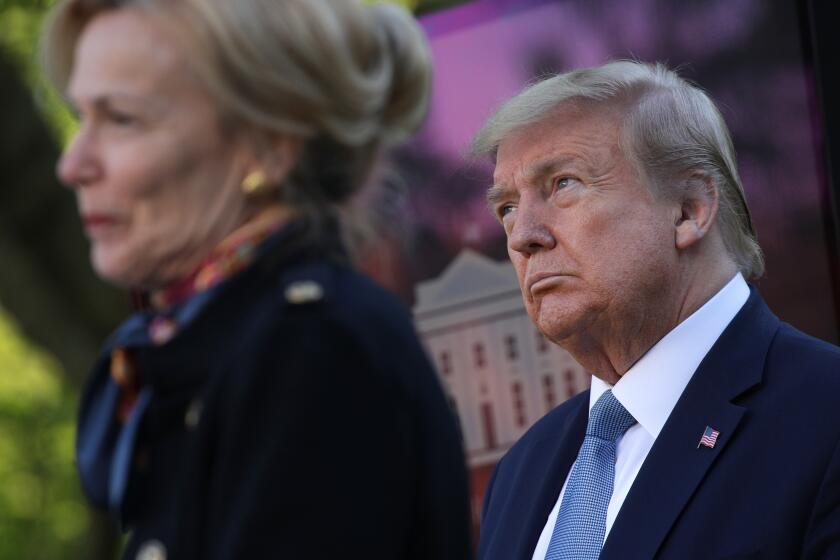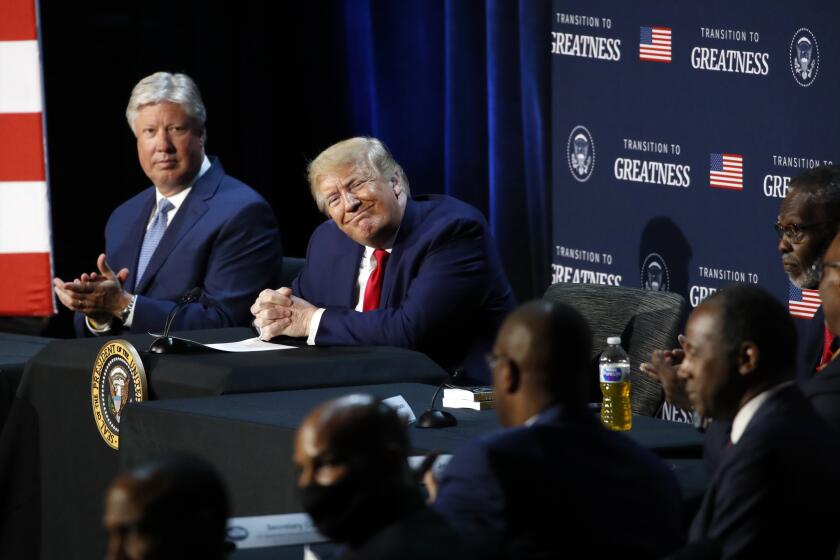Why is Trump lashing out at polls? Look at the numbers

Polling has long been a favorite topic of President Trump’s hyperactive Twitter feed, but lately he has been more angry than boastful.
“They are called SUPPRESSION POLLS, and are put out to dampen enthusiasm,” Trump recently wrote of surveys by CNN and other news outlets that show him significantly trailing rival Joe Biden. “Despite 3½ years of phony Witch Hunts, we are winning, and will close it out on November 3rd!”
His bellicose tone comes as polls show the presumptive Democratic nominee opening up an 8-point advantage nationally against Trump and, more important, notching smaller but consistent polling leads in key swing states such as Michigan, Florida and Wisconsin.
“Given the size of his margin and the consensus across polls, I think there’s pretty strong evidence that Biden holds a clear lead,” said Charles Franklin, director of the Marquette Law School Poll in Milwaukee. “While it’s possible the polls are wrong, they would have to all be wrong” to overstate Biden’s support.
Seniors are the country’s most reliable voters. A shift away from Trump in key states like Arizona could cost the president reelection.
Democrats are hardly crowing — at least openly. They remember all too well their near-certainty in 2016 that Hillary Clinton would win, a view reinforced by national polls (which were largely accurate) and some key state polls (which were not).
“Ignore the polls. We can’t take anything for granted this November — the stakes are simply too high,” Biden tweeted Wednesday, along with a link to register to vote.
The missteps from four years ago have fed into a sense that Trump’s true standing can defy conventional survey methods.
At this time in 2016, polling showed Clinton besting Trump, albeit at a slightly narrower margin than the current Biden-Trump matchup. Clinton largely maintained her advantage in national polls through election day, and national surveys came within 1 percentage point of her margin in the popular vote.
But the presidency is decided by the electoral college, and state polls — including Franklin’s Marquette survey — failed to capture Trump’s narrow victories in the previously Democratic strongholds of Michigan, Pennsylvania and Wisconsin, which catapulted him to the Oval Office.
In their postmortems, pollsters identified one key problem with state-level polling: the failure to account for the education levels of respondents.
“What we saw in 2016 was that, depending on the education, you voted for very different candidates, particularly among white respondents,” said Josh Clinton (no relation to the former presidential candidate), who teaches political science at Vanderbilt University and co-directs the school’s Vanderbilt Poll.
Trump performed especially well with white voters without college degrees, while his rival proved more popular with those with higher education levels. By failing to account for those differences, pollsters understated Trump’s support.
Now, Clinton said, state pollsters are more diligent in accounting for education levels, a move he believed would make those surveys more accurate.
There’s little for Trump to cheer in the latest set of opinion surveys. Not only does he lag Biden in head-to-head matchups, but a growing majority disapprove of his job performance. He gets low marks on his temperament and trustworthiness, and more people prefer Biden in terms of ability to handle the COVID-19 pandemic and race relations, two issues that have surged to the top of the campaign agenda.
Moreover, the president’s numbers are slumping among women and independents, two groups that cost Republicans control of the House in the 2018 midterm election. Older voters, who backed Trump in 2016, now say they prefer Biden. One recent poll by the Public Religion Research Institute found that 62% of white evangelical voters hold favorable views of Trump, a decline of 15 percentage points among that bedrock constituency.
Trump does maintain a modest advantage as to whom voters trust to best handle the economy, an important indicator for an incumbent who has staked much of his reelection pitch on the robust stock market performance and low unemployment the country enjoyed during most of his term. But even there, the pandemic and the economic shutdown it necessitated have cut into Trump’s approval rating.
The president appeared especially bothered by a CNN poll released Monday showing Biden with a sizable 14-point lead, based on responses from roughly 1,100 registered voters. Trump’s campaign demanded the network retract the poll and apologize; CNN declined the extraordinary request. Trump tweeted a memo from a GOP pollster accusing CNN and other outlets of deliberately underrepresenting how many Republicans would likely vote in November, thus downplaying the president’s chances.
“The refusal to screen for actual likely voters is creating an under-polling of Republicans and therefore Trump voters,” the pollster, John McLaughlin, wrote. “It seems intentional. It’s exactly what the media did in 2016. Let’s prove them wrong again.”
The argument harks back to 2012, when Republicans rallied around an obscure website that claimed to “unskew” polling that showed GOP nominee Mitt Romney trailing President Obama. The mathematical contortions proved unfounded when Obama handily beat Romney, as polls had indicated.
“All those people who were making these John McLaughlin-like arguments in 2012 were completely wrong,” said Matt Barreto, a UCLA political scientist and Democratic pollster. “They had these harebrained ideas, and that’s exactly what this is.”
Despite the raft of good polling news for Biden, there remain warning signs for the presumptive Democratic nominee. Surveys suggest less-than-fervent enthusiasm for the former vice president among Black voters, the backbone of the Democratic base.
“If the election were to happen today, it would not look good for Biden” with that crucial group, said Ray Block Jr., a professor of political science and African American studies at Penn State University.
The risk for Biden is not that significant numbers of Black voters will flip to Trump but that they may not vote at all. The recent protests against racial injustice in response to George Floyd’s killing by Minneapolis police prove that the Black community is clearly motivated for political action, Block said. But, he cautioned, “it will be up to the Biden camp to move with, not against, this momentum if he seeks the support of Black voters.”
Nearly six weeks after Trump stopped daily televised briefings on the coronavirus, he is acting like the deadly pandemic is over. It’s not.
Trump holds another advantage: Polls have shown that his die-hard base is more enthusiastic about voting in November than Biden’s supporters. Trump’s campaign will likely try to further dampen excitement for the Democrat as the election nears by pummeling Biden with negative advertising.
“By November, voters are going to have a choice,” said Neil Newhouse, a veteran Republican pollster. “They already know what they love and hate about Donald Trump. About that they’re absolutely certain. What the voters don’t know is what they love and hate about Joe Biden, and that’s what the campaign is all about.”
And there are still nearly five months left — plenty of time for voter sentiments to change.
“We should have a great deal of confidence Biden is ahead today,” said Mark Mellman, a longtime Democratic strategist who conducted polling for the presidential campaigns of Bill Clinton and John Kerry. But, he cautioned, “that’s not the same thing as saying Biden will be ahead on election day.”
More to Read
Get the L.A. Times Politics newsletter
Deeply reported insights into legislation, politics and policy from Sacramento, Washington and beyond. In your inbox three times per week.
You may occasionally receive promotional content from the Los Angeles Times.














